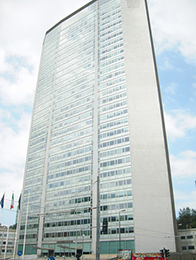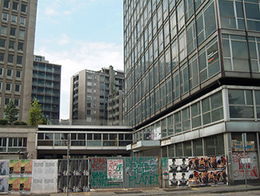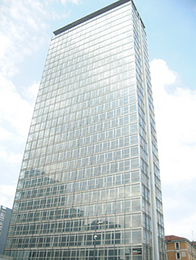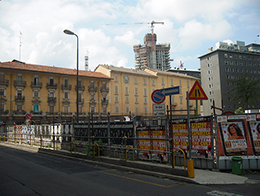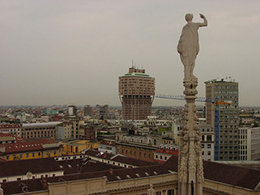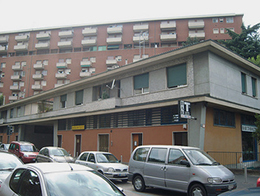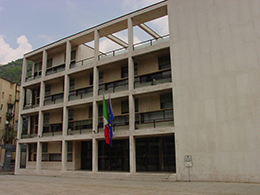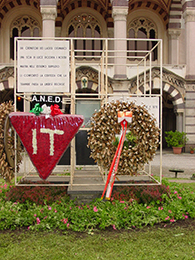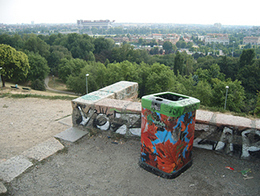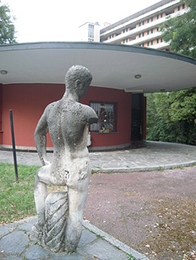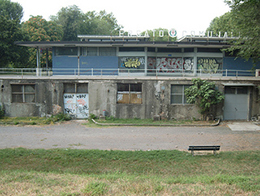No section
Scott Budzynski (Savannah)
Potential Cities
Imagining the New
urn:nbn:de:0009-21-42533
“E il destino di Milano è tenace: la cittĂ viene distrutta, la popolazione dispersa, viene sottomessa da invasori di non eccelsa qualitĂ . Eppure si rialza, si riforma, prosegue il suo filo, riprende le sue potenialitĂ .” [1]
(Ludovio Festa and Carlo Tognoli)
Arrival in Milan
Leaving the Stazione centrale in Milan, the pedestrian’s view is drawn to the iconic Pirelli Tower (Fig. 1) . The 127.10 meter high-rise marks out the beginning of a collection of tall modernist buildings of a commercial area called the Centro direzionale. Originally built for the tire manufacturer Pirelli, the tower is now the seat of the government of Lombardy and its high security tract lends it an air of inapproachability. The polyhedronal slab, however, was meant to extoll its main architect Gio Ponti’s conceptualization of a modern city. In the issue of Domus dedicated to the inauguration of Pirelli Tower, Ponti writes, “Buildings developed vertically are not at the best isolated: towns must grow with groups of high buildings, separated by green spaces and room for traffic, but near each other, like clumps of high trees, not scattered, as up to today in Milan. (The New York skyscrapers clustered together give the city a fascinating appearance both by night and by day).” [2]
Fig. 1. Gio Ponti, with Egidio Dell'Orto, Antonio Fornaroli, Alberto Rosselli and Giuseppe Valtolina, Engineers: Pier Luigi Nervi and Arturo Danusso, Pirelli Tower (Sede della Regione Lombardia), 1955-60, Piazza Duca d'Aosta, 3, Milan, Source: https://www.flickr.com.
Ponti makes it clear in his statement that the Pirelli Tower was not to be a singular structure, but a potentiality for the whole city of Milan, an insertion of a new vision into the city. The urban ideal remained a fragment, as the quarter was never fully realized. It could best be brought into perspective in the associative device of cinematic montage. In the opening of Michelangelo Antonioni’s 1961 La notte, the tower’s windows appear as reflective screens framing the construction of other surrounding high-rises. Pirelli Tower thus literally becomes an image of the city taking shape, a mirror for reflecting what Milan could become. [3]
It was originally planned that the Centro direzionale would relieve the historic center of Milan of business activities. Both the Piano AR (Architetti Riuniti) and the PRG (Piano regolatore generale) ’53 had envisioned such a center, but it was the latter’s design that was to be at least partially implemented. [4] Antonioni’s La notte portrays life in the new quarter as both a pristine realization of new living, as well as entrapping and aseptic. Moving past Pirelli Tower onto via Luigi Galvani, a less perfect image of the area takes shape. Another impressive tower, Torre Galfa (Melchiorre Bega, 1956-1959) (Figs. 2 and 3) could be easily overlooked. Parts of it are bordered up, the dusty windowed facades are covered with graffiti and the doors chained shut. Looking closer, however, the beauty of the skyscraper’s stringent simplicity becomes evident. In contrast to the octagonal Pirelli Tower, the 109 meter Torre Galfa is a rectangular slab. And while Pirelli Tower’s glass windows are more opaquely reflective, Torre Galfa’s allow a view into the interior, simultaneously condensing these with exterior reflections.
Fig. 2, 3. Melchiorre Bega, Torre Galfa, 1956-59, via Fara 41, Centro direzionale di Milano, Source: https://www.flickr.com.
Empty and neglected, the tall glass monolith appears as a ruin of postwar modernity, a testimony to the elegance of and the belief in functionalism for a center that was never completed. Many of the buildings are run-down and appear vacant. Open space was not taken into consideration in the often dense constructions and the mix between new and old appears accidental, rather than reflexive and intentional (Fig. 4). Today a new generation of skyscrapers has sprung up around the quarter, many as part of the Expo Milano 2015, so that the area has become a type of palimpsest of the high-rise. Throughout, Milan contains layers of modernist construction attesting to contrasting narratives of the city. Pirelli Tower is countered by the 106 meter Torre Velasca (1956-1958) (Fig. 5) by Studio BBPR. Directly in the center of town, this high-rise represents a different urban vision than Ponti’s. It recalls continuity with the Gothic forms of the historic center, particularly with the cathedral, while still retaining a grounding in modernist principles.
Fig. 4. View of Centro direzionale taken in 2013, Source: https://www.flickr.com.
Fig. 5. Studio BBPR, Torre Velasca, 1956-58, seen from Duomo di Milano, Source: https://www.flickr.com.
Besides individual buildings, it was housing settlements, such as Quartiere QT8, which in the history of Milanese modernism were to be new social models for the city. Under the directorship of Piero Bottoni, the quarter (Fig. 6) was to apply the lessons of Italian Rationalism to solve the housing shortage generated by bomb destruction and the influx of immigrants. But such semi-autonomous settlements were also opportunities to re-form the city in a rationalist manner. Many such projects remain today as fragments of the potential of the new city. They may be thought of as insertions of potentiality into the city. Milan’s modernist fragments are not only functionalist constructions, they are objects for mediating an ideal of the future.
Fig. 6. View of QT8 (Quartiere Triennale 8) taken in 2013, Source: https://www.flickr.com.
Concurrently projecting into the future, the “new” in architectural design represents a tradition, as Gio Ponti explains in 1955 in calling for architects in Milan to express a continuity of the new in designing new houses in a new modus. As architects for centuries had developed new styles, continuing to do so would be, according to Ponti, to return to a true tradition. [5] Traditions of the new and of re-construction have been important in the formation of Milan’s urban identity. In his authoritative and posthumously published volume Milano: Costruzione di una cittĂ , Giuseppe de Finetti, Novecento architect and architectural writer, situates the bomb destruction in Milan during World War II and the subsequent reconstruction in a trajectory of destruction and reconstruction in which the re-entry into the city in 1167 after it was destroyed by Barbarossa is central. [6] The same anxious spirit, relates de Finetti, of old and new destruction and the current – de Finetti is writing in 1945 - distraught state of the city incites thoughts of renewal and the search for new and more wise urban norms. [7] He continues that the city has been saved as something spiritual and eternal through those who gave their lives to combat barbarism. [8]
Although seemingly addressing the current situation and the fight against Fascism, the open formulation insinuates a continuity in Milan of a battle against barbarism. [9]
The tradition of destruction and renewal is taken up by theater critic Eligo Possenti in 1962 in the more popularly orientated photographic volume Addio vecchia Milano, Bunodì Milano nuova. Possenti emphasizes and heroicizes the disappearance of the old and the emergence of new construction with phrases such as “The walls have disappeared to let glass triumph.” [10] Milan’s modern architects are praised as being in a tradition of teaching architecture at the Politecnico infused with the principles of a modern spirit that had been present in Futurism and the work of Antonio Sant’Elia. [11] Yet, the old has not in fact disappeared. While the new is dominant, the author describes the old city as facing the new one and the old houses as being embedded into blocks of new construction. [12]
Milan’s narrative of the new city involves destruction and reconstruction and in the period following World War II, this narrative involved an initial sense of optimism regarding the possibility of a more coherent urban form based on principles of modernist architecture as well as the associated formation of a new form of living. In this essay, the establishment of an orientation towards the future of the city in Milan is understood as a representation of the city rooted in memories of the new. As representation, the new city is dependent upon a constellation of objects of meaning holding the perspective of the new into place. The new is approached here in terms of an imagined dream-like moment of anticipation with which material objects are charged. As referenced above, Milan’s narratives involve a continuity of the new, which could only reach completion in the imagination. During the post-war period, Milan was charged with a feeling of anticipation of what form the city could take. However, the new city remained bound to the old one and much of what was built was in disparity to ideals of a coherent urban image. Ponti already disparages the reality of new construction in 1955 and in his capacity as editor of Domus reflects on the dream-like nature of high-quality architecture as beyond realization on a large scale. [13] It is in fact the impossibility of its realization that makes the theme of modern architecture and planning in Milan of interest. This paper intends to demonstrate the nature of the new as an imaginative insertion into the built environment and proposes that the potential of the new manifested in modernist architecture is bound to memories of that potential. Concrete instances of the city as space for the transformation and continuation of those potentialities in Milan will be given through a discussion of narratives of the modern city - as arrangements of objects of meaning -, particularly of the narratives of Rationalism in Milan and its reestablishment following World War II.
The City as Collage of Mentalities
The Italian Pavilion of the fourteenth Venice Architecture Biennale was organized under the title “Grafting.” In the [edifying] prologue, grafting as a form of modernist practice is described as an insertion into the Italian city: “The 2014 Italian Pavilion thus examines the attempts by the Italian architectural design culture in the last century to intervene in a fragmented and complex landscape in an ‘edifying’ manner, seeking out great technical and formal innovations and grafting gems of great modernity between the cracks separating earlier strata.” [14] Milan is a central focal point in the exhibition and is singled out amongst the European cities that suffered extensive bomb damage during World War II. Its approach to reconstruction consisted not in a literal reconstruction of what was destroyed, nor a complete transformation of the city into a new one, but an eclectic one of continuity. [15] Milan is examined through the relationship of fragments that do not result in a singular form of memory or history, but a representation of complexity of generative models and mentalities. [16]
A similar method of approaching the seemingly contradictory perspectives of progress-orientated utopia and memory-focused tradition is antedated in Colin Rowe and Fred Koetter’s idea of the collage city from their book of the same name published in 1978. [17] When derived of the “linear imperatives”, the time of progress may be rearranged. [18] Indeed, the delineation between what Rowe and Koetter describe as the building as theatre of memory – buildings referring back to and facilitating a memory of the past – and the building as theatre of prophecy – buildings evoking a not-yet present better world – is not that impermeable. [19] In the case of Milan and Italian modernism – as will later be discussed with examples -, architectural and urban projects evoking a better city to come, were dependent upon narratives – as arrangements of elements important to the idea of Italian modernism – held in place through the medial aspect of the built environment and embedded in memories of what the new for the city of Milan could mean. The city, in essence, became a memory theatre of the modern for re-arranging the meanings of the new in the urban space.
The Archeology of Space
This analyses of modernist architecture implies that its meanings may shift and that they are fragmented and layered. In 2007, Documenta 12 expounded upon the archeology of modernity, to which Mark Lewis writes: “If we accept that we are modern and that we continue to live in the time of modernity, then we know that modernist representational forms have staked their legibility and ‘success’ in the figuring of other futures, necessarily utopian, in the possibilities of modernity.” [20] In referring to a utopian state, modernity claims a sense of timelessness, which as Lewis notes, adds to its attraction. [21] It has now itself become historical, a ruin to be categorized. [22]
It could be said that modernist architecture represents a mode of thinking about the future that is now historic and so is a type of remembering an anticipatory moment.
It is an object for calling up narratives, including memories. Space as such is understand as potential, originating in a moment between subject and object, in which a sense of unity may be conferred or challenged through a constellation of objects both material and fantasized.
Historically, there is a precedent for the employment of architecture on a psychic level to establish an inner sense of order. Presence and absence, or the mental engagement with absent constructions to re-establish order comes to focus in Frances Yates’ The Art of Memory through the ancient story told by Cicero of the poet Simonides. Called to perform a lyric poem at a banquet, Simonides dedicated half the poem to the Dioskouri Castor and Pollux. During the banquet the poet was summoned to the door, but as he reached it, there was no one there. Simonides’ absence from the banquet, however, saved his life. The roof of the banquet hall collapsed as he was at the door and he remained the only survivor. As the bodies were mangled beyond identification, Simonides was asked to identify them and was able to do so by remembering the hall and the places where the quests had been sitting. [23] Orderly arrangement was thus seen as essential for good memory. And a means for such arrangements was the mental establishment of a place and the insertion of images of things to be remembered inside it, so that place and image would function in a similar way to the writing of letters upon a wax writing-tablet. [24] Turning to Aristotle, Yates cites from De anima in discussing memory and imagination. Both draw from past sense impressions, which the intellectual faculty orders. [25]
Sigmund Freud too suggests a relationship between architecture and memory, but in this case through architecture as ruin. In Civilization and its Discontents, Freud takes the city of Rome as a model for memory, which he sees as ultimately failing because “There is clearly no point in spinning our phantasy any further, for it leads to things that are unimaginable and even absurd. If we want to represent historical sequence in spatial terms we can only do it by juxtaposition in space: the same space cannot have two different contents.” [26] Freud had imagined the uncovering of the Roman ruins in a perfect state only to realize their contraposition to each other. It is this in fact which allows memory in the form of the dream to condense and form layered meanings. As in the classical art of memory, it is absence that plays a decisive role in Freud’s description of memory and the built environment as ruin. The ruin may function as an object for the projection of history, including the projection of multiple histories onto the same site, depending upon the perspective.
The psychoanalyst and cultural theorist Christopher Bollas explains, “History is a person's transformation of the past into a story which that person can tell himself or herself. Sometimes the story does indeed derive from the past, but even for the most sincere of analysands, his or her history will be more like a myth.” [27] Bollas speaks of aesthetic space allowing for a creative enactment to transform the object relation, or of “culturally-dreamed-of transformational objects.” [28] These objects do not simply mediate a sense of identity, but they transform the self. Objects here are understood in terms of object relations theory in which subjecthood is dependent upon the mediation of so called objects referring to figures from beyond the subject, which early on are both outer and internalized. These objects may be magically ordered to create a sense of unity in the subject. That is, the world is brought into an inner sense of meaning through a dream-like control over the object world, both present and absent. [29] The transformation of the subject, therefore, is as much a transformation through the internalized world as through actual figures of that world. One of the pioneers of object relations theory, Donald Winnicott, posits the ability to relate to inner or imagined objects with the capacity to have cultural experience. [30] Cultural activity occurs, according to Winnicott, in potential space, in a space belonging both to the dream world and to exterior reality. [31]
Considering object relations theory in terms of architecture and urban planning implies an understanding of the built environment in its dream-like transformational state. The objects of the city may entail buildings and monuments, the city itself, but also figures and ideas of importance for the mental holding together of the city. Modernist architecture’s sense of urban unity is highly imaginary and is dependent upon an ordering of objects of meaning intended to transform the subject through the experience of urban space in a time not yet realized. Built structures recall a trajectory of meanings deriving from desires to change the given urban situation that are themselves layered and multifaceted as the futures imagined are varied and often shift focus. Projected and materialized designs parallel the work of the memory theatre in arranging in a virtually planned space in order to evoke unity. The material form – if in fact even realized at all - of this unity, as in the case of Milan, is often incomplete and one urban vision of many.
Milan’s Tradition of Rationalism
Looking at the city as an imagined unity, the space of the city of Milan oscillates between the narratives inserted into the built environment in lieu of a lack of real coherence. After the destruction of World War II, Milanese architects could draw upon or remember histories of the future to attempt to construct a functionalist/rationalist city. Both the construction of the new and the reconstruction of the old was spurred on by the bombing of the city in World War II with over 30% of the city's buildings completely destroyed and another 30% torn down in the aftermath. Such destruction was viewed by modernist architects as a chance, such as by the architect and city planner Piero Bottoni, who in 1949 laments that this unique – however tragic – opportunity was missed. The hopes invested in reconstruction failed due mainly to property speculation and the resultant urge to build densely. [32]
As the birthplace of Italian Rationalist architecture, Milan became a center for the activities of modernist architects, including the dissemination of their ideas through such magazines as Casabella, Domus and Quadrante. While Rationalism is sometimes used more generally to refer to the Modern Movement in architecture in Italy, it more specifically refers to a movement begun by a group of young architects, Gruppo 7, after they had graduated from the Milan Politecnico in 1926. The group developed into M..A.R. - Movimento Architettura Razionale – in 1928, then M.I.A.R. - Movimento Italiano per l'Architettura in 1930, shortly after which it ended as a unified movement.
From the start, Rationalist architecture was to a large degree a projection into the future based on ideals of functionalism and the functionalist city. [33] Having just, or almost, graduated, the members of Gruppo 7 had not yet had the chance to realize their visions, but turned away from the reigning style of academic eclecticism as well as from the classicist modernism of Novecento architecture and looked towards figures of European functionalism, especially to Le Corbusier. In 1927 a few members traveled to Stuttgart to view the new Weissenhof Estate and to participate in a Werkbund exhibition there with drawings and models. Here they were confronted with the materialization of functionalist principles which they had only conceived of visually in Italy.
The best-known attempt at bringing the aims of Italian Rationalism and Fascism together is Giuseppe Terragni's Casa del Fascio, 1932-36, in Como Fig. 7 . [34] A native of Como, Terragni had studied at the Milan Polytechnic and was an original and active member of Gruppo 7 as well as a co-founder of the magazine Quadrante and CIAM participant at the 1933 meeting on the theme of “The Functional City,” which took place on the boat Patris between Marseille and Athens and which was to serve as a foundation for the Charter of Athens. Casa del Fascio demonstrates principles of functional architecture with the exposure of its support structure and strict geometric form, while also expressing a sense of movement with an alternation of open and closed forms. Here the structure based on progressive principles and openness was to serve as a meeting place for the local Fascist officials and as stage for Fascist rallies.
Fig. 7. Giuseppe Terragni, Casa del Fascio (today: Casa del Popolo), 1932-36, Como.
While Terragni’s Como project may be the most iconic structure of Rationalist design, it was in Milan where the Rationalist city was to be created on a large scale, at least in thought. The Rationalist movement was founded in Milan and the magazine, Casabella, that was closely associated with it was based in the city and most of the involved architects lived and worked in Milan. [35] Rationalist positions on housing were particularly strong. Together with Pietro Lingeri, Terragni designed a housing complex – Casa per abitazioni - on Corso Sempione – the northern axis of the city then under development – that was realized from 1933-36 and which today is complemented by Piero Bottoni’s nearby residential high-rise (1953-58) constructed in the post-war period. Large-scale Rationalist-style housing settlements were built, such as the Quartiere Fabio Filzi (Franco Albini, Renato Camus and Giancarlo Palanti, 1936-38, viale Argonne, via Birago, via Illirico), which later provided the setting for important scenes of Luchino Visconti’s Rocco and His Brothers (1960). 1933 saw the initiation of the Triennale di Milano in the Novecento architect Giovanni Muzio’s newly completed (1933) Palazzo dell’Arte in Parco Sempione. Under the directorship of Gio Ponti and Giuseppe Pagano – architect, critic and editor of Casabella closely associated with the Rationalists – the exhibition was dedicated to the theme of modernist housing and included temporary housing models designed by Italian modernist architects, including a contribution – la Casa Elettrica (the Electric House) by the core group of Rationalists, the Gruppo 7. [36] These projects all stood for alternative ways of understanding the city and were discussed and visualized in the magazines Casabella, Domus and Quadrante, but remained exceptions in the actual urban fabric.
Re-Constructing the Modernist Narrative
Directly after World War II, Rationalist design turned to the function of remembering. Its cubist grid form appears in miniature as a memorial designed by the architectural group Studio BBPR. The work of 1946 Fig. 8 is set in the Cimitero Monumentale of Milan and commemorates those who died in German concentration camps. The openness of the grid is contrasted with inserted plaques recalling the victims of the camps, but also emphasizing the passing from tyranny to the rising of liberty. An urn is set within the memorial with soil from Camp Mauthausen in Austria, where various member of the Italian modernist movement died. The architectural group Studio BBPR stands for the names Gian Luigi Banfi, Lodovico Barbiano di Belgiojoso, Enrico Peressutti and Ernesto Nathan Rogers, who had also meet during their studies as the Milan Polytechnic. Slightly younger than the original Gruppo 7 architects, they became adherents of the Rationalist Movement as well as supporters of Fascism. The memorial and its architects present a dilemma of the post-war years, re-situating the narrative of Italian Rationalist architecture in a coherent mental space. Studio BBPR members had, in fact, like many of their colleagues, turned to the Resistenza in the final war years. Banfi himself died in Mauthausen, but it was decided to keep his initial in the group name, so that the architectural team itself became a type of memorial.
Fig. 8. Studio BBPR, Monumento ai Morti nei campi di sterminio nazista, Cimitero Monumentale, Milan, 1946.
Through his writing and editorial activities, Rogers became the most prominent figure of BBPR. The architect was co-editor of Quadrante from 1933-36, was briefly editor of Domus from 1946-47 and of Casabella from 1946-47, with which he is most associated and whose named he changed to Casabella continuitĂ . Rogers very quickly addressed the theme of Fascism in his initial postwar articles, such as in “Catarsi” (Catharses) for Casabella, still under the previous name Casabella costruzioni. In “Catarsi” he begins by admitting that almost all the Italian modern architects passed through a phase of Fascism, and that while the past cannot be altered, it should be talked about. These architects also contributed to a national redemption, according to Rogers, some paying with their lives as martyrs, such as Banfi, but also Giuseppe Pagano, the Milanese architect and publicist and previous editor of Casabella, who also turned from Fascism to the Resistance and died in Mauthausen. Throughout the article, Rogers praises Pagano and defends his, and the Rationalists' ideals, which they had mistakenly identified with Fascism. Thus he writes that Mussolini's true architect was Piacentini and that they simply wanted to save the people with comfortable, clean and beautiful houses. [37]
The house for Rogers was much more than the creation of living space, but was symbolically charged as a container for society and was central to his architectural concept. In January 1946 he uses the term casa dell'uomo, the house of man, and writes that the house of man is cracked as if it were a sea vessel taking water. [38] Creating housing can be seen in Rogers’ texts as giving a shape to society, as in the same article he writes, “It's about constructing a society.” But it is also about forming a taste, a technical means and a morality and a magazine can be an instrument and support in stabilizing the criteria of choice. [39] The magazine itself becomes the house of man as Rogers so states in his farewell text in Domus in December of 1947, speaking of the house of man which was entrusted to them, a creature saved amongst the ruins of the storm. [40] Both Domus and Casabella contain the word house in their names and as mouthpieces for the Italian Modernist Movement, it is clear that the house refers to one different than the previously existing one. The narrative created here imagines a renewal of society on a psychic level. In explaining the relationship between the evocative aspect of the built, Christopher Bollas writes “In this respect, cities continually present their inhabitants with new objects – and the planning stage, when proposals are floated in the press, may constitute an important psychic element in the population's relation to the new.” [41] The new in this case was a continuity of the potential of Rationalist architecture and city planning. Experts would treat the built space as a formable unity, which existed in the absence of a felt sense of coherence. It is the city itself which can be seen here as the house of man in which a continuity could be remembered and re-thought on a textual and visual level through editorial activities.
The dream-like nature of the Rationalist endeavors after the liberation of Italy is reflected in Rogers formulation of “ideals” which were, in his description, never so close to being reached as at that time, because the architects were finally able to awaken an interest in their work even in those who were unable to appreciate them before. [42] The destruction caused through the war was seen as a chance to realize a functionalist city. Rogers as well as Belgiojoso, Piero Bottoni and other Rationalist architects worked together on a new urban plan for Milan in which the city would be re-arranged according to functionalist principles. The plan was conceived of already in 1944 and is known as the Piano AR, or Architetti Riuniti – Re-united Architects. Again, the name itself refers to a remembering of Italian Modernism. Rationalist architects re-unite to solve the problems of the war-time destruction. The plan’s text mythologizes the group in arranging a history in which they are singled out as protagonists entrusted to re-creating a new city as a representation for a new way of living, “In the first months of 1944, after vast destruction carried out in Milan through the bombings of the preceding summer, a group of architects knew that the urban problem would appear as a fundamental need of reconstruction. They felt it as their duty to initiate studies for a new building plan, that should be an element of a new Italian and European life.” [43]
Milan as a text is a symbolic space of Italian Rationalism for the reconstruction of society upon principles of functionalism, and it represents a continuity of those principles. A central task of the Piano AR was to decentralize Milan, spreading it out towards the outlying cities and connecting it with those through transportation systems, i.e., highways and trains, with motorways cutting through the historic city-center. Semi-autonomous settlements were to be constructed in the outlying areas and a new commercial center was to be built to the Northwest of the traditional city center, which was to remain a place for cultural activities with some living space. In all, the population of Milan was to be reduced from 1,100,000 to 850,000. [44] As for Rogers, the theme of the house is central to Bottoni's urban concepts. In 1943 he writes that a new house will be built on the ruins of the old one and will be better than that which stood before. [45] The house becomes an interface between the individual and collective in which the beauty of the rational lies in the fact that every part should have its function determined through the interest of the collective. [46]
Living Space as Representation
While the Piano AR was not realized, some of its ideas were integrated into the Piano Regolatore '53 (PRG 53), on which Bottoni and other Rationalist architects collaborated. While it too remained incomplete, several housing settlements were carried out, including the experimental model QT8, Quartiere Triennale 8, under the directorship of Piero Bottoni. The settlement was a part of the eighth Milanese Triennial in 1947 on the theme of housing. While housing models were shown at the exhibition, the actual settlement was constructed north of the Parco Sempione, five kilometers from the center in an area of 939,000 sq.m. The centerpiece of the project was in fact a transformation of the ruins of Milan, an artificial hill called Monte Stella, around 60 m high in a park of 370,000 sq.m. The hill Fig. 9 developed gradually as building ruins were brought to the building site to fill in a pit, which soon turned to a hill. The idea then came about of creating a green anchor to the new settlement of modernist housing. At the opening of the Triennial in 1947, the QT8 settlement was still a building site and the hill an accumulation of rubble. A visual idea of its future could, however, be seen in a diorama in which staffage figures look out from the hill onto an Arcadian modernist environment. Bottoni later wrote in 1954 of the diorama in a book about the project that the inhabitants of QT8 looking down from the hill onto the settlement have come from different parts of the city to live here and are witnessing the new quarter grow piece for piece. Most did not know that they would become living actors in a new manifestation of human society. [47]
Fig. 9. View from the summit of Monte Stella today, Source: https://www.flickr.com.
Milan as a potential city is inserted through the medial arrangement of QT8 into the existing city both imaginatively and physically. At moments they coalesce, such as in the visual-spatial arrangement of Bottoni’s QT8 Pavilion (1951) against Pietro Lingeri and Luigi Zuccoli’s social housing complex Casa Ina-casa (1949-51) and the statue of a youth (Fig. 10). The buildings were finished for the ninth Triennale in 1951 and the statue was found by Bottoni in the exhibition depot. As the site was still largely under construction at the time, the constellation became an identificatory image for the whole of the quarter. QT8 was in fact completed, but the social aspect is not strongly present in the quarter. The Mercato communale is literally a ruin (Fig. 11). Monte Stella is well-visited, but feels disconnected from much of the quarter. Many of the buildings around the pavilion and complex are run down and the ensemble is set off on via Giuseppe Pagano Pogatschnig, so that when seen, it is as if the ideal of QT8 takes form again.
Fig. 10, 11. Piero Bottoni, Padiglione per mostra e riunioni, QT8, via Giuseppe Pagano Pogatschnig, 1951, with Casa Ina-casa di undici piani, 1949-51, by Pietro Lingeri and Luigi Zuccoli, 1950-51, in the background, Source: https://www.flickr.com (left). Mercato Comunale, via Isernia, QT8 (right), Source: https://www.flickr.com.
It is precisely through its incompleteness that modern Milan acquires its potentiality. Through its partial destruction during World War II, the city could be re-imagined in narratives of a new society. These narratives were attached to architectural objects in which a sense of collectively was to be generated. But these objects themselves were embedded in constellations involving a history of Italian modernism in which the city’s planned and realized structures were anticipated by their medial aspect. Particularly in the years following World War II, the dream of a continuation and full realization of a Rationalist city seemed possible. Today, many of the objects of the new in the city are neglected and in a state of ruin. Their imagined completion as an urban model and transformative potential were never realized and their power of evocation is often no longer apparent. Even at the time of their construction, their focus on an imagined time to come was itself determined by memories of the new. When put back into a specific perspective, however, the potential of the new may still evoke an idea of a now historic future.
[1] Lodovico Fest / Carlo Tognoli: Milano e il suo destino. Dalla cittĂ romana all’Expo 2015. Milan, 2010, p. 8. “And Milan’s destiny is tenacious. The city has been destroyed, its population dispersed, and it’s been subjugated by invaders of a less than lofty nature. And yet, the city rises up, it re-forms, it follows its thread and regains its potentiality.” Trans. by author.
[2] Gio Ponti: “Si fa coi pensieri.” In: Domus 379 (June 1961), p. 1-30, 28.
[3] For a discussion of the montage, insertion and the imagination, see: Jane Rendell: “Insertion as Montage.” In: Art and Architecture. A Place Between. London, New York 2008, p. 103-120.
[4] Corinna Morandi: Milan. The Great Urban Transformation. Trans. Richard Sadleir. Venice 2005, p. 54-56.
[5] Adele Carla Buratti: “L’architettura ‘ideale’ nella Milano della ricostruzione.” In: Giorgio Rumi / Adele Carla Buratti / Alberto Cova (Ed.): Milano ricostruisce 1945-1954. Milan 1990 p. 173-206, 176.
[6] Giuseppe de Finetti: Milano. Costruzione di una cittĂ . Milan 2002, p. XLIII-XLIV.
[7] Ibid., p. XLIII.
[8] Ibid.
[9] Ibid., p. XLIV: “Ma quello stesso spirito che ci fa penosi delle colleganze tra le colpe antiche e nuove e la durezza e bruttezza del vivere presente nella cittĂ sconvolta, incita a pensieri di rinnovamento, alla virile ricerca di norme e leggi piĂą sagge. Nel meditare sulla ricostruzione l’anima si ispira al sarificio degli eroi che non hanno piegato davanti alle torture ed alla morte, che nella cittĂ umiliata hanno congiurato per combattere la barbarie, che col loro martirio hanno salvato la cittĂ come cosa spirituale ed eterna.”
[10] Eligio Possenti: Addio vecchia Milano. Buondì Milano nuova. Milan 1962/68, p. 63-64. Author’s translation.
[11] Ibid., p. 64
[12] Ibid.
[13] Buratti, 1990, p. 196.
[14] Cino Zucci: Grafting, Vol. 1. Grafting. The New as Metamorphosis. Venice 2014, p. 36.
[15] Pierluigi Nicolin: “Modern and Postmodern Milan.” In: Cino Zucchi / Nina Bassoli (Ed.). Grafting, Vol. 2. Milan. Laboratory of Modernity. Venice 2014, p. 9-17, 9-10.
[16] Ibid., p. 9.
[17] Colin Rowe / Fred Koetter: Collage City. Cambridge, MA, London 1998, p. 144-145.
[18] Ibid., p. 144.
[19] Ibid., p. 32-49.
[20] Mark Lewis: “Is Modernity our Antiquity.” In: Ruth Noack / Georg Schllhammer, / Roger M Buergel (Ed.). Documenta Magazine 1-3, 2007 Reader. Cologne 2007, p. 40-64, 46.
[21] Morandi, 2005, p. 44.
[22] Ibid., p. 44-45.
[23] Frances Yates: The Art of Memory. London 1966, p. 17.
[24] Ibid.
[25] Ibid., p. 46-47.
[26] Sigmund Freud: Civilization and Its Discontents. Trans. and Ed. James Strachey. New York 1989. (1929), p. 18-19.
[27] Christopher Bollas: The Infinite Question. London 2009, p. 31-32.
[28] Bollas: “The transformational object.” In The Christopher Bollas Reader. London and New York 2011, p. 1-12, 11-12.
[29] Donald Winnicott: Human Nature. London 1988, p. 74-75.
[30] Winnicott: “The Concept of a Healthy Individual” (1967). In: Clare Winnicott / Ray Shepherd / Madeleine Davis (Ed.). Home is Where We Start From. New York and London 1986, p. 21-38, 36.
[31] Ibid.
[32] Piero Bottoni: “Il punto sull’architettura” (1949). In: Graziella Tonon (Ed.). Una nuova antichissima bellezza, scritti editi e inediti, 1927-1973. Bari 1995, p. 262-264, 264.
[33] Bottoni: Antologia di Edifici Moderni in Milano. Milan 2010. (1954), p. 9.
[34] Bruno Zevi: Giuseppe Terragni. Trans. Luigi Beltrandi. London 1989, p. 12-16.
[35] Buratti, 1990, p. 175.
[36] Graziella Leyla CiagĂ : “La casa per tutti. La Triennale e la cittĂ .” In: Graziella Leyla CiagĂ / Graziella Tonon (Ed.). Le case nella Triennale. Dal parco al QT8. Milan 2005, p. 12-33, 12.
[37] Ernesto Nathan Rogers: “Catarsi” (1946). In: Luca Molinari (Ed.). Esperienza dell’architettura. Milan 1997, p. 62-71, 66-67.
[38] Rogers: “Programma: Domus, la casa dell’uomo” (1946). In: Esperienza dell’architettura, p. 80-84, 80.
[39] Ibid.
[40] Rogers: “Saluto” (1947). In: Esperienza dell’architettura, p. 90-92, 90.
[41] Bollas: The Evocative Object World. London 2009, p. 55.
[42] Rogers: “Saluto,” p. 91.
[43] Bottoni: “Il piano regolatore” (1955). In: Una nuova antichissima bellezza, p. 319-334, 328.
[44] Ibid.
[45] Bottoni: “Crociata o torneo dell ‘casa per tutti’” (1943). In: Una nuova antichissima bellezza, p. 225-234, 226-227.
[46] Bottoni: “Cosa è l’urbanistica” (1945). In: Una nuova antichissima bellezza, p. 242-245, 245.
[47] Bottoni: Il quartiere sperimentale della triennale di Milano. Milan 1954, p. 2.
Volltext ¶
-
 Volltext als PDF
(
Größe:
3.6 MB
)
Volltext als PDF
(
Größe:
3.6 MB
)
Lizenz ¶
Jedermann darf dieses Werk unter den Bedingungen der Digital Peer Publishing Lizenz elektronisch ĂĽberÂmitteln und zum Download bereitÂstellen. Der Lizenztext ist im Internet unter der Adresse http://www.dipp.nrw.de/lizenzen/dppl/dppl/DPPL_v2_de_06-2004.html abrufbar.
Empfohlene Zitierweise ¶
Scott Budzynski: "Potential Cities_". In archimaera#006 (2015). (urn:nbn:de:0009-21-42533)
Bitte geben Sie beim Zitieren dieses Artikels die exakte URL und das Datum Ihres letzten Besuchs bei dieser Online-Adresse an.

